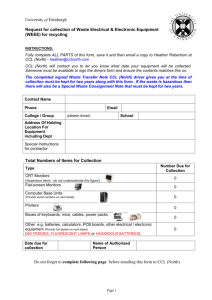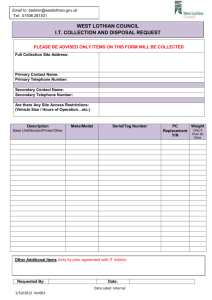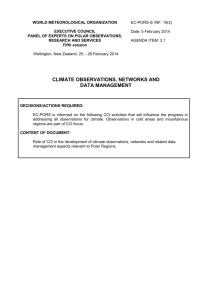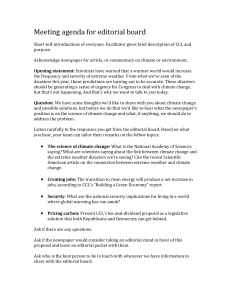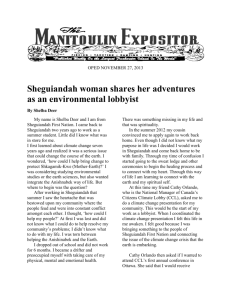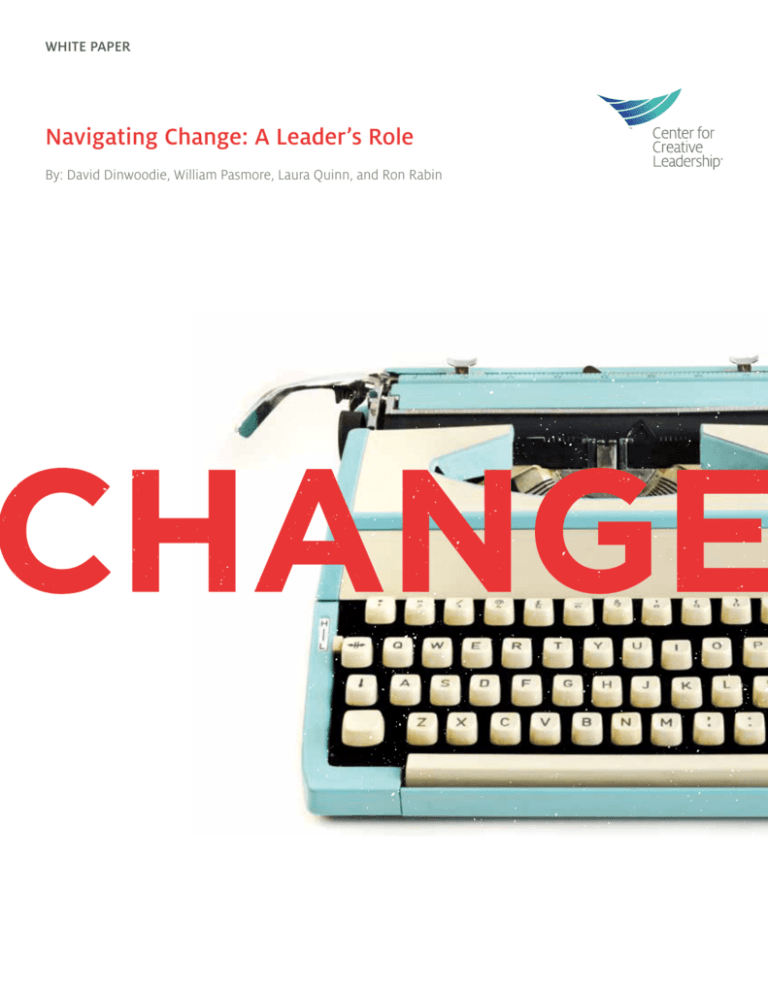
WHITE PAPER
Navigating Change: A Leader’s Role
By: David Dinwoodie, William Pasmore, Laura Quinn, and Ron Rabin
Contents
Introduction1
Change Management Is Understood; Change Leadership Is Overlooked
2
Change Leadership Operates at Three Levels
3
In Action: Learning to Lead Change
4
The Bottom Line
7
About the Authors
9
INTRODUCTION
THE EFFECTS OF CHANGE ARE FELT UP, DOWN, AND AROUND
OUR ORGANIZATIONS. Change can be seen as positive or negative,
exciting or demoralizing, vital or unnecessary, easy or difficult—often
all of the above.
The role of mid- and senior-level leaders in making change happen is
critical. Managers of teams, projects, departments, and functions are
in a unique and powerful position. These are the leaders who must
translate the vision of change from the C-Suite to the ground troops,
help direct reports navigate the emotions of change and transition,
and influence change agents to generate alignment and commitment
for the change effort to be successful.
How can managers become better equipped to steer their
organizations and their people through change?
Rapid organizational change is the No. 2
leadership development challenge in the next two
to five years—and, logically, change is the second
most important topic for leadership development.
–CCL LEADING INSIGHTS STUDY, 2013
©2015 Center for Creative Leadership. All rights reserved.
1
CHANGE MANAGEMENT Is Understood;
CHANGE LEADERSHIP Is Overlooked
Change is a given and a top priority across all
types of organizations, but studies consistently
show between 50 and 70% of planned change
efforts fail. It doesn’t bode well for organizational
ambitions if critical change is (at best) just as
likely to fail as it is to succeed.
How can organizations improve the odds of
success? We have found that many organizations
have mastered the operational or structural side
of change, but give little effort to the people side
of change. To gain the desired results from a new
direction, system, or initiative, organizations
need the benefit of change leadership along with
change management.
2
©2015 Center for Creative Leadership. All rights reserved.
Change leadership is about the phases of
change—and the emotions associated with those
phases—that people must navigate when change
is constant. Change leadership requires leaders,
and the organization as a whole, to address
beliefs and mindsets and to develop the practices
and behaviors that help people adapt to change.
In contrast to change management—which is an
outside-in process with a focus on structures,
systems and processes—change leadership is
the inside-out element of meeting the change
challenge. It’s about enlisting people in change
and keeping them committed throughout, in the
face of uncertainties, fears, and distractions.
CHANGE LEADERSHIP
Operates at Three Levels
Mid- and senior-level managers both create change and respond to change directives
coming from above. To effectively lead these efforts, managers need to navigate change
at three levels—Self, Others, and Organization. Here are questions to ask at each level:
SELF
How do I deal with change? What is my current change challenge? What is my role as a
change leader and what do I need to do differently? What is my default leadership style
when faced with driving significant change? How do my change style preferences impact
those around me? How do I ensure we have leadership capability for change throughout
the organization?
OTHERS
How do I help my people through change, especially when they have no control or
choice? How do I understand—and respond to—the different perspectives, feelings, and
responses people have to change while achieving alignment with organizational aims?
How do I build relationships and persuade supporters, detractors, and fence-sitters to get
onboard with the changes I am tasked with?
ORGANIZATION
How do I lead change in the context of the larger organizational culture and political
realities? How do I forge a network of change agents throughout the organization? How
do I influence up, down, and across the organization? How do I ensure that change
is right for my team as well as right for the organization? How do I ensure we have
leadership capability for change throughout the organization?
©2015 Center for Creative Leadership. All rights reserved.
3
In Action:
Learning to Lead CHANGE
How can managers approach their real-world change challenges?
CCL takes the view that managers need to have the mindsets,
skillsets, and toolsets for leading change. Here are five key ideas
an effective change leader needs to know:
1. PEOPLE NAVIGATE CHANGE FROM A CONTINUUM
OF CHANGE STYLE PREFERENCES.
Different people have different built-in reactions to change. Managers who
pay attention to change preference can better understand why people react the
way they do when faced with change. These managers are more prepared to
address concerns, leverage different contributions, avoid pitfalls—and adapt
their own change approach as needed. The Change Style IndicatorTM from
Discovery Learning, Inc., describes the two extremes as well as the midpoint
on the continuum of change preference:
•CONSERVERS accept the current structure, systems, and
processes. They are champions of incremental change and strong
advocates of continuous improvement within the established
business model.
•ORIGINATORS like to challenge current structures, systems,
and processes. They are champions of expansive business model
change and tend to focus on new possibilities, vision, and
direction.
•PRAGMATISTS tend to focus on getting the job done. They are
champions of change that is functional and often see merit in
the perspectives of both conservers and originators—as long as a
clear business case exists for one approach or the other.
Change Style IndicatorTM is a trademark owned by Discovery Learning, Inc.
4
©2015 Center for Creative Leadership. All rights reserved.
2. LEADERS NEED TO NAVIGATE CHANGE
THROUGH FOUR PHASES.
When managers understand the process of change, they have a better picture of what they
need to do and when. They can anticipate and mitigate many predictable problems. They
know not only what actions to take but also what must be done today to prepare the way
for tomorrow. CCL breaks the process into four parts that occur in parallel:
DISCOVER. Change begins with understanding. What is the need for change?
Will it be evolutionary or revolutionary in nature? What is the scope? What is
the urgency? What communities, stakeholder groups and change agents need
to be taken into consideration? Who are the people leading the change and are
they aligned and committed? What is the level of commitment?
DECIDE. The vision is formed, the change terrain is mapped, and plans are
created. The core team and early adopters begin to engage employees in
decisions about the change. At this stage, deciding about how to frame the
change initiative, build relationships, motivate others, and create alignment and
commitment are key leadership functions.
DO. Communicating and taking steps to enact the change begins. The rollout may
be slow, or fast-paced, but leaders should recognize that no matter how quickly they
choose to move, people still need time to adapt to change. Change leaders must
show commitment to the change initiative—and, above all, to the people who are
affected by the change. Cracking the code of change is an emotional undertaking,
which requires relationship-building across an interrelated web of change agents.
DISCERN. Change may continue and solidify . . . or it may fall off or fail to take hold.
Change leaders must discern what is working and what isn’t in order to maintain focus,
energy, resources, and support to ensure change sustains over time. Learning—what
has and has not been effective in the change process—and adapting future plans to
ensure progress are critical to success.
©2015 Center for Creative Leadership. All rights reserved.
5
3. STABILITY AND CHANGE IS A POWERFUL POLARITY.
As the organization evolves over time, stability and change must coexist. It is one of many organizational
priorities or demands that may appear to be diametrically opposed. When leading change, managers
must understand that stability vs. change is not a problem to solve but a polarity to manage. To achieve
the full performance potential of the organization, energy must be given to both poles simultaneously.
We hold constant the organizational elements that are critical for reaping the benefits of today’s business
model while driving the innovations that propel us toward our desired future.
STABILITY
Ensure that our current
business model is solid,
efficient, effective, and stable.
and
CHANGE
Implement the changes
necessary to be more
competitive in the future.
By understanding the polarities of change and seeking the sweet spot of “both/and,”
change leaders can present a change effort in a way that others can embrace.
4. PERSUASION SKILLS
ARE ESSENTIAL.
Change and influence are inextricably
linked. Influence is about gaining not only
compliance but also the commitment
necessary to successfully drive change.
It is also about mapping out the critical
change agents that must be brought
onboard, and defining what “buy-in” looks
like from each stakeholder that will lead
to a successful outcome.
6
©2015 Center for Creative Leadership. All rights reserved.
5. RESILIENCE IS REQUIRED.
Resiliency helps people handle the
pressure, uncertainty, and setbacks
that are part of going through change.
Managers need to build their own
reserves and resiliency, in support of
their mental and physical health. They
also can guide others to face change
in healthy and sustainable ways. This
is increasingly important as people
experience the cumulative effects of
ongoing and often turbulent change.
The Bottom Line
Navigating change is an organizational, team, and individual process. Executives, top
leaders, and HR professionals can gain better results from strategic and operational
change when they
•recognize the imperative to both lead
change and manage change.
•communicate to mid- and seniorlevel managers that part of their job
is to guide other people through the
emotional upheaval that comes with
change.
•invest in key managers to develop
the mindsets, skillsets, and toolsets
to be effective leaders of change.
•reframe the change message and
pitch it in a way that engages team
members, direct reports, senior
leaders, and system-wide change
agents.
•listen to the concerns of those close
to the front lines as their insights and
experience are critical to execution
success.
With effective change leadership, organizations
will overcome the pitfalls of failed change
efforts and drive towards a stronger, more
effective, and more prosperous future.
©2015 Center for Creative Leadership. All rights reserved.
7
Want More on Leading CHANGE?
CCL offers a two-day course, Navigating Change, to help managers guide
their teams through a current change. Participants work with peers and
CCL experts, are immersed in a change simulation activity, learn their
personal preference for change, and plan how to apply—and sustain—
what they learn.
CCL works with organizations to help them navigate through small and
large organization change efforts. Contact us for details.
You may also be interested in the CCL white paper Transformational
Change: An Ecosystem Approach Lessons from Nature for Those Leading
Change in Organizations
Also, for more about the complexities of change, a book by CCL’s Bill
Pasmore, Leading Continuous Change: Navigating Churn in the Real World,
is available for purchase at ccl.org.
8
©2015 Center for Creative Leadership. All rights reserved.
About the Authors
Dr. David L. Dinwoodie is the Center for Creative
Leadership’s (CCL®) Global Director, Individual and Team
Leadership Solutions, a role in which he is responsible
for CCL’s global portfolio of programs, products and
services in the Open-Enrollment, Custom, Coaching
and Assessment Services lines of business. He is a
coauthor of Becoming a Strategic Leader: Your Role in Your
Organization’s Enduring Success, and a research associate
on the Leadership Across Differences project. He
holds a master of International Management from the
Thunderbird School of Global Management and earned
an MBA from ESADE Business School in Barcelona.
His doctoral degree is from Aston University (UK) in
the area of organizational and workgroup psychology.
Before joining CCL, he held management positions
with pan-European and global responsibilities at Ernst
& Young, BICC General Cable, Planeta de Agostini,
Bristol-Myers Squibb, and EADA Business School. He
also taught courses in strategic management, change
management and leadership development at institutions
such as ESADE Business School (Spain), EADA Business
School (Spain), Centrum Business School (Peru), and
Universidad de Rosario (Colombia).
William Pasmore, PhD, joined the Center for Creative
Leadership in January 2008 as Senior Vice President
and Organizational Practice Leader. An international
authority in organizational leadership, he leads CCL’s
efforts to help clients develop the larger organizational
leadership systems that increase their overall
performance and enable their individual leaders to
thrive. Pasmore previously served as partner in the
Corporate Learning & Organizational Development
Practice of consulting firm Oliver Wyman Delta,
where he headed the global research practice and
worked personally with top executives of Fortune 500
companies on organizational architecture, succession
planning, talent management, and strategic planning.
He holds a BS in aeronautical engineering/industrial
management and a PhD in administrative sciences, both
from Purdue University.
Laura Quinn, PhD, is the Global Director of
Organizational Leadership Solutions, managing CCL’s
work in strategy development and execution, talent
sustainability, organizational and leadership culture,
organizational change, transformation, and executive
team leadership. A certified feedback coach, Laura also
trains in several CCL programs. She has made numerous
conference presentations on her work and has published
in CCL’s Leadership in Action, Business Communication
Quarterly, and the Journal of Management Communication.
Prior to joining CCL, Laura was a professor in the
University of Colorado’s communication department, and
worked for seven years in the high-tech industry, holding
management positions in finance and materials. She
has a BA in business and an MA in communication from
the University of Colorado. Her PhD is in organizational
communication from the University of Texas at Austin.
Ron Rabin is a Senior Learning Technologist at the
Center for Creative Leadership. He combines his passion
for innovative technology with his background in
learning pedagogy to make learning more effective and
impactful. Prior to joining the Center, Ron worked as
an Educational Technologist and IT Consultant for IBM.
As a member of IBM’s Center for Advanced Learning
(CAL), he designed training programs and e-learning
solutions using approaches like video stories, podcasts,
simulations, social networking, and personalization.
He was writer and producer of video scripts streamed
to 30,000 IBM managers globally, design lead for
simulations and collaborative learning, and product
manager for a blog-like tool used by IBMers for
reflection and collaboration. He also served as co-lead
of IBM’s research partnership with Stanford University.
Before joining CAL, Ron served as a software developer
and solution architect with IBM’s Vancouver Innovation
Centre, where he worked primarily on K-12 and highereducation solutions. Ron received his BA from Stanford
University, his MA from Yale University and his PhD from
Cornell University in musicology. He studied in Vienna
on a Fulbright scholarship prior to teaching at Cornell
University and the University of Michigan. He returned
to school and received his Dipl. Sc. in computer science
from the University of British Columbia.
Additional contributors: Diane Reinhold and Harold Scharlatt
To learn more about this topic or the Center for Creative Leadership’s programs and products,
please contact our Client Services team. +1 800 780 1031 +1 336 545 2810 info@ccl.org
©2015 Center for Creative Leadership. All rights reserved.
9
The Center for Creative Leadership (CCL®) is a top-ranked,
global provider of leadership development. By leveraging
the power of leadership to drive results that matter most
to clients, CCL transforms individual leaders, teams,
organizations and society. Our array of cutting-edge
solutions is steeped in extensive research and experience
gained from working with hundreds of thousands of
leaders at all levels. Ranked among the world’s Top 5
providers of executive education by the Financial Times
and in the Top 10 by Bloomberg Businessweek, CCL has
offices in Greensboro, NC; Colorado Springs, CO; San
Diego, CA; Brussels, Belgium; Moscow, Russia; Addis
Ababa, Ethiopia; Johannesburg, South Africa; Singapore;
Gurgaon, India; and Shanghai, China.
CCL - Americas
www.ccl.org
+1 800 780 1031 (US or Canada)
+1 336 545 2810 (Worldwide)
info@ccl.org
Greensboro, North Carolina
+1 336 545 2810
Colorado Springs, Colorado
+1 719 633 3891
San Diego, California
+1 858 638 8000
CCL - Europe, Middle East, Africa
www.ccl.org/emea
CCL - Asia Pacific
www.ccl.org/apac
Brussels, Belgium
+32 (0) 2 679 09 10
ccl.emea@ccl.org
Singapore
+65 6854 6000
ccl.apac@ccl.org
Addis Ababa, Ethiopia
+251 118 957086
LBB.Africa@ccl.org
Gurgaon, India
+91 124 676 9200
cclindia@ccl.org
Johannesburg, South Africa
+27 (11) 783 4963
southafrica.office@ccl.org
Shanghai, China
+86 21 6881 6683
ccl.china@ccl.org
Moscow, Russia
+7 495 662 31 39
ccl.cis@ccl.org
Affiliate Locations: Seattle, Washington • Seoul, Korea • College Park, Maryland • Ottawa, Ontario, Canada
Ft. Belvoir, Virginia • Kettering, Ohio • Huntsville, Alabama • San Diego, California • St. Petersburg, Florida
Peoria, Illinois • Omaha, Nebraska • Minato-ku, Tokyo, Japan • Mt. Eliza, Victoria, Australia
Center for Creative Leadership® and CCL® are registered trademarks owned by the Center for Creative Leadership.
©2015 Center for Creative Leadership. All rights reserved.
Pub. Jan 2015/Rev. Oct.. 2015

